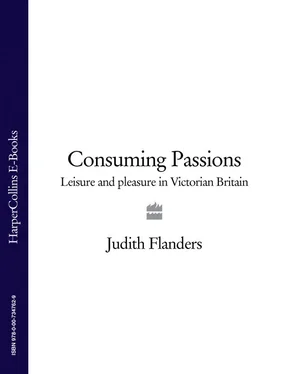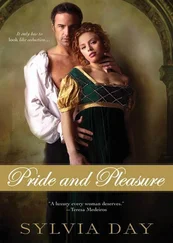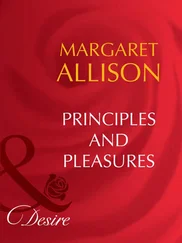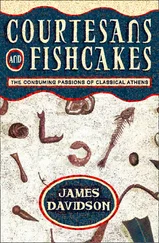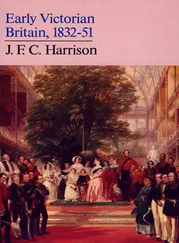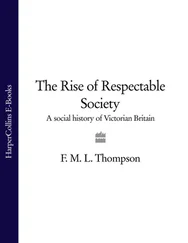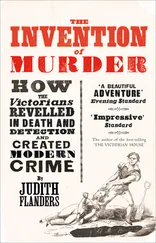Many items that had been undreamt of luxuries to the grandparents, or even the parents, of the children of the Industrial Revolution became conveniences; less than a generation later they were no longer even conveniences: they had become necessities. Living without sugar, without tea, without cotton, glass or cutlery became unimaginable to much of Britain’s population. Over the course of the nineteenth century, mass production of goods, improved distribution of those goods by new and faster forms of transport, promotion by advertising in newspapers and magazines, and new methods of retailing all combined to produce a seemingly endless stream of things that could be acquired by the consumer. It was not expensive rarities that created the new middleclass world of plenty and ease: it was the small comforts of hot, sweet drinks, or cheap and cheerful clothes—perhaps ultimately better symbols of the new world than all the machinery and technical ingenuity that made these items possible. As Gibbon noted in 1781, ‘The plenty of glass and linen has diffused more real comforts among the modern nations of Europe, than the senators of Rome could derive from all the refinements of pompous or sensual luxury.’ 3
But the consumer revolution was not only a matter of things. Commercial entertainment—the selling of leisure and pleasure—was also now accessible to the masses, creating myriad business opportunities. Theatre, opera, music-making; pleasure gardens and fairs; newspapers, magazines, books; holidays and tourism, seaside outings and excursion travel; spectator sports such as racing and football—in the nineteenth century these became available to many, who could increasingly afford to pay for their entertainment. No longer was the pub or the annual or monthly fair the prime venue for leisure. The age of mass entertainment had arrived, and the unruly crowd—avidly, enthusiastically—had become eager customers.
In Consuming Passions I have chosen to look not at the contents of the world of leisure, but at the containers: not at the literary merits (or otherwise) of books, newspapers and magazines, but at the availability of reading material; not at the subject matter of plays, but at staging and the technological development of theatrical presentation—at lighting, special effects and spectacle; at football and racing not as sporting competitions, but as paying spectator events.
Of course commercial leisure has always existed, in some form or another, but the masses previously had minimal access to much of it. The Industrial Revolution is often represented as having created a new world of commerce and commercialism; of factory routine, endless grind, and dark, Satanic mills. It did that. But it also brought colour, light and entertainment. This new world is the one I want to visit.
1 From Arcadia to Arcade:The Great Exhibition
THE 1ST OF MAY 1851. Prince Albert is on the dais, welcoming the throng to the Great Exhibition of the Works of Industry of All Nations. Joseph Paxton’s extraordinary Crystal Palace, as it has swiftly been nicknamed, throws off sparks of light in the bright sunshine. The choir sings the ‘Hallelujah Chorus’ from the Messiah . It seems that all the doubt, turmoil and trouble of the previous decades has at last been overcome: machinery, technology and science are in the ascendant, and will set the world free. Britain, the world’s first industrial society, will lead the way into a glorious future, which can be seen, all mapped out, in the courts and aisles of the Crystal Palace.
The building itself is a triumph of technology: Paxton’s great innovation has been to design perhaps the world’s first—and definitely the world’s largest—prefabricated building, using in his cast-iron and glass structure principles previously applied only to engineering projects. The Crystal Palace, deep in Hyde Park, is a cathedral to the glories of industry, in which power and steam are deified: a twenty-four-ton lump of coal greets visitors at the entrance, a precursor to the steam engines, hydraulicpowered machinery, locomotives, looms, spinning machines, steam hammers and more inside.
Earlier that year The Times had reported a speech given by the Prince, in which he had held out an enticing vision of the future: ‘The distances which separated the different nations and parts of the globe are rapidly vanishing before the achievements of modern invention…The products of all quarters of the globe are placed at our disposal, and we have only to choose which is the best and the cheapest for our purposes, and the powers of production are intrusted to the stimulus of competition and capital.’ 1Others had less exalted ideas. Albert and his supporters and encouragers were concerned with the benefits, both moral and industrial, that were to be found in commercial endeavour, but, in the brave new world of free trade and capitalism, many more were content simply to enjoy, or profit from, the results of those endeavours. The Great Exhibition gave many their first taste of the mass market, a thrilling peek into a future of plenty and consumption. For the Great Exhibition brought with it more than merely machinery. It brought things —tens of thousands of things, things piled high in the aisles of the Crystal Palace; things representing the hundreds of thousands more things that were now being manufactured and could be purchased.
The organizers of the Great Exhibition had not meant it to be this way. The origins of the event could be found in many converging trends, but the one that was the most distinctive, the most British, was the club. The Goncourt brothers, those nineteenth-century Parisian novelists and diarists, mocked the national fondness for this institution: if two Englishmen were washed up on a desert island, they said, the first thing they would do would be to form a club. 2Certainly, by the eighteenth century, clubs were seen as an integral part of the civilizing process in Britain. Joseph Addison, laying down the rules of urbane as well as urban living in the Spectator , wrote, ‘Man is said to be a Sociable Animal, and, as an Instance of it, we may observe, that we take all Occasions and Pretences of forming our selves into those little Nocturnal Assemblies, which are commonly known by the Name of Clubs .’ * 3
Initially informal, sociable outings (the noun probably developed from the verb, from the custom of clubbing together to pay for dinners
After the closure of the Tatler , Addison and Steele founded the Spectator , which has been called ‘one of the most triumphant literary projects of the age’. 4It was published daily for the next twenty-two months, and transformed periodical writing in England. Addison wrote the first number, introducing the ‘Spectator’ himself—a wry observer of the foibles of polite life—who together with his friends formed a club whose members included the Whig merchant Sir Andrew Freeport, the elderly ladies’ man Will Honeycomb, and, ultimately the most famous, the country squire Sir Roger de Coverley.
and drinks), clubs gradually through the eighteenth century developed into a fairly constant form: they were on the whole private groups of men (almost always men), who met on a regular if not necessarily frequent basis, mostly in public places such as coffee houses, taverns, inns or pubs, where their meetings were given point by a focus on one specific aim, whether it was recreation, sociability, education, politics, or a shared profession. *
Soon these clubs expanded further into daily life. Addison wrote approvingly once more: ‘When [men] are thus combined for their own Improvement, or for the Good of others, or at least to relax themselves from the Business of the Day…there may be something very useful in these little Institutions and Establishments.’ 6By the mid eighteenth century there were possibly as many as 20,000 men meeting every night in London alone in some form of organized group. And it was not just London that had convivial meeting groups: by the early eighteenth century most provincial towns had a range of clubs, whether county societies, military groups, antiquarian or philosophical societies, or simple social clubs. Bristol, with a population of 50,000 in the 1750s, had bell-ringing, clergy, county, floral, political, musical, ‘Ancient Britons’, Masonic and charitable groups. Norwich, with 36,000 people, had bell-ringing, floral and clergy groups, as well as nine Masonic lodges, a natural-history society, a music society, uncounted sociable clubs, and nearly fifty benefit societies. Oxford had a ‘catch’ club—for ‘all true lovers of good fun, good humour and good music’—Irish clubs, Welsh clubs, a poetry and philosophical club, a bell-ringing club, an antiquarian society, and a number of Masonic lodges, dining clubs and social clubs—including the Eternal Club, the Jelly Bag Society, and the Town Smarts, whose members appeared in ‘white stockings, silver buckles, [with] chitterlings [shirt frills] flying, and hair in kidney’ †—as well as the more common benefit, political, social, sporting, naturalhistory and college clubs. Even Northampton, with a population of only 5,000, managed a floral club, a Masonic lodge and a philosophical society. 7Though most of Scotland had barely any clubs, Glasgow and Aberdeen had a few, while Edinburgh had more than twenty with an occupational or other aim—religious, social, political, musical, antiquarian—and several that were purely social, like the Easy Club (founded in 1712) for ‘mutual improvement in conversation that [members] may be more adapted for fellowship with the politer part of mankind’. 8It was this thirst for self-improvement that motivated many club-goers.
Читать дальше
